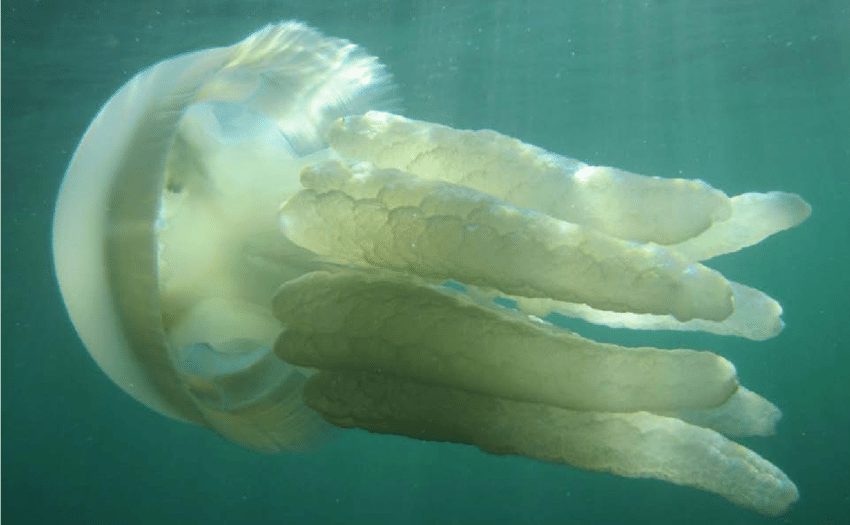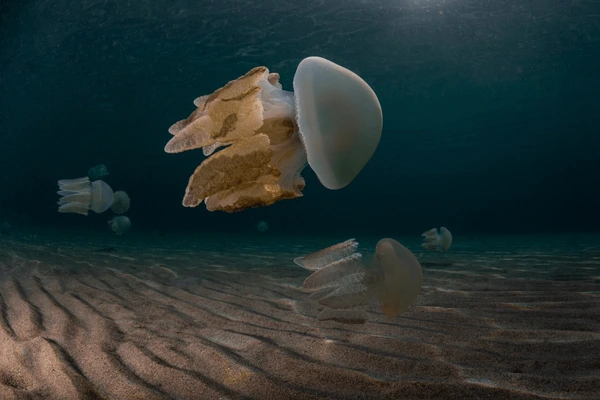Among the rich variety of sea creatures, the jellyfish occupies a special place Catostylus mosaicus, known as "motley jellyfish" or "mosaic jellyfish". It is one of the most common jellyfish in the warm waters of the Pacific and Indian Oceans, as well as in the coastal areas of Australia.
This species impresses with its unusual appearance, gentle movements in the water and bioluminescent abilities. Despite its beauty, the jellyfish has low toxicity, which can cause irritation in humans, but is not fatal.

Scientific classification
🔬 Classification of Catostylus mosaicus:
✔ The Kingdom: Animals (Animalia)
✔ Type: Cnidarians (Cnidaria)
✔ Class: Scyphoid (Scyphozoa)
✔ Row: Kornerotu (Rhizostomeae)
✔ Family: Catostylidae
✔ Gender: Catostylus
✔ View: Catostylus mosaicus
📌 Interesting!
This jellyfish got its name from unusual color scheme - its dome has mosaic pattern in different shades of brown, blue or purple.
Description and appearance
💠 Main Features:
• Dome diameter: 30-50 cm
• Weight: up to 2 kg
• Colour: from brown to bluish-purple
• Building: the dome is rounded in shape, without long stinging tentacles
• Oral apparatus: it consists of eight mouth blades
🔹 How does it differ from other jellyfish?
* Has color scheme in the form of a mosaic pattern
• Compact dimensions, compared to other large jellyfish
• It does not have long stinging tentacles, which reduces the risk of severe burns in humans
📌 Interesting!
Catostylus mosaicus can glow in the dark, thanks to bioluminescent cells in tissues!
Living environment
🌍 Where does the pied jellyfish live?
• Australia (Tasman Sea, Great Barrier Reef)
• Indian Ocean
• Western Pacific
🌊 Optimal living conditions:
• Water temperature: 18–28°C
• Salinity: medium or high
• Depth: it is most often found in shallow water or mangroves
📌 Interesting!
Catostylus mosaicus often forms huge clustersthat can block water in bays and coastal areas.
Life cycle
🔄 How does the pied jellyfish live and reproduce?
1️⃣ Adult jellyfish releases eggs and sperm into the water
2️⃣ Larva (planula) floats in the water column
3️⃣ Polyp attaches to the sea floor
4️⃣ Strobilation - the polyp is divided into many tiny jellyfish
5️⃣ Young jellyfish they turn into adults
📌 Interesting!
Under certain conditions polyps can survive for decades and become more active in the face of climate change.
Nutrition and lifestyle
🍽 What does the pied jellyfish eat?
• Zooplankton (crustaceans, microscopic animals)
• Phytoplankton (seaweed)
• Fish larvae
💡 How does she hunt?
Mouth blades filter water, trapping small organisms.
📌 Interesting!
The jellyfish doesn't have a real brain, but it responds to light and chemical signals in the water.
Is it dangerous for humans?
⚠ The danger is low!
* Stinging cells cause a slight burning sensation
• Contact not deadly
🚑 What should I do when contacting you?
✔ Wash your skin with sea water
✔ Avoid fresh water (it activates toxins)
✔ Use vinegar to neutralize the burn
📌 Interesting!
Unlike dangerous jellyfish, such as Chironex fleckeri, stinger of Catostylus mosaicus does not cause severe reactions.

Meaning for a person
🎣 Fishing industry:
* In China and Japan catching colorful jellyfish for food
* Used in medicine and cosmetology
🏖 Impact on tourism:
* Jellyfish can create mass gatherings near beaches
* Often become an object of observation for divers
📌 Interesting!
In Japan, jellyfish are used for cooking sushi and salads!
Interesting facts
📌 Top 5 facts about Catostylus mosaicus:
1️ ⃣ has unique mosaic pattern on the dome
2️ ⃣ can bioluminescence in the dark
3️ ⃣ there are an ocean water filterby cleaning it of small organisms
4️ ⃣ included in the diet of sea turtles and large fish
5️ ⃣ used in asian cooking
Conclusion
Catostylus mosaicus – this is an unusual, beautiful and useful creature in the marine ecosystem. It is not only cleans ocean water, but also it serves as food for many marine animals.
🌊 Studying this jellyfish helps us better understand the balance of the ocean ecosystem!